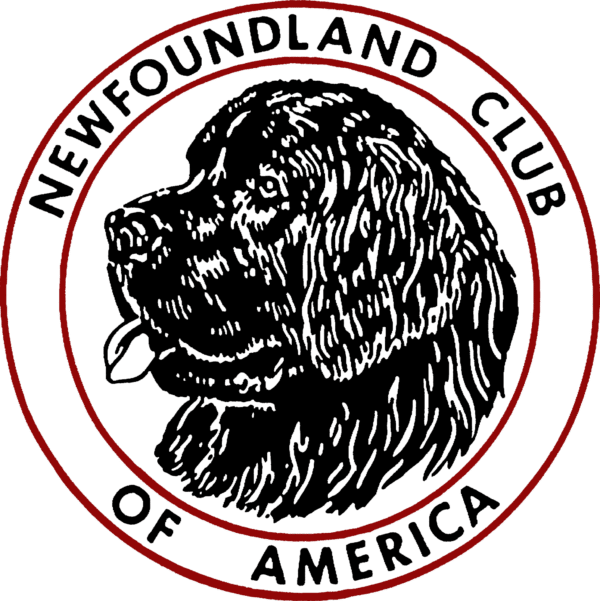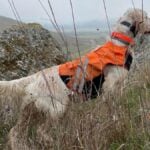
Home » Judging The Newfoundland It Is All About The Balance
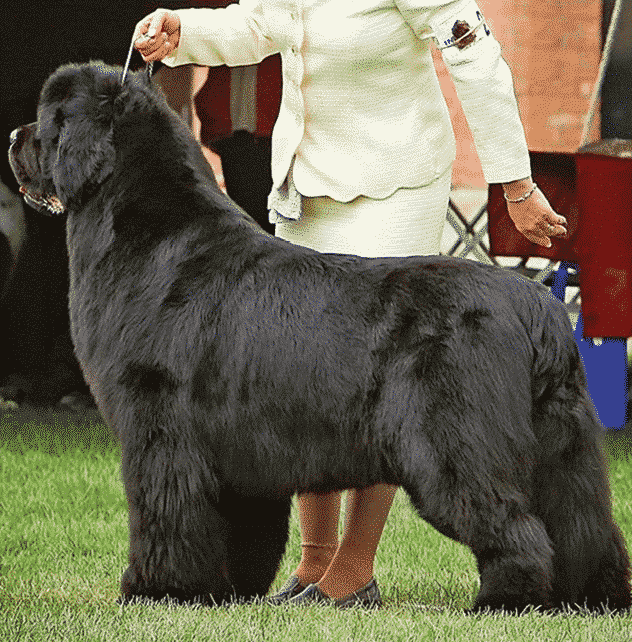
Judging The Newfoundland It Is All About The Balance | The Newfoundland is a swimmer, a hauler, and a gentle companion. The Breed Standard is built around these traits. Type comprises those physical characteristics that distinguish the Newfoundland from other breeds.
The original Newfoundland Standard is over 100 years old, and while modifications have been made in the interest of clarity, its essentials remain unchanged. The intention is to keep the Newfoundland as it has been over the years—large, strong, and active; at home in water and on land; a multi-purpose dog with natural life-saving instincts, capable of heavy work as well as a devoted companion for both child and adult.
The following excerpts from the work, This is the Newfoundland, were written by the late Mr. & Mrs. Major B. Godsol.
“Remember that type, balance, and general appearance are of the utmost importance. As a breeder, shun those faults that are hard to breed out. As a judge, remember that any dog can gait soundly, but no matter how well he moves, unless he looks like a Newfoundland, he is not typical of the breed. Type is the embodiment of a Standard’s essentials.”
We put much emphasis on conditioning and handling in the show ring in America today. To be sure, fine conditioning and good handling of dogs are things we all like to see at shows. When it comes to judging an individual dog, only the degree to which it measures up to the Breed Standard counts. In other words, “All the grooming and skillful handling cannot change a mediocre dog into a top one, nor are beauty treatments transmitted.”
Temperament is of primary importance
The Newfoundland is a sweet-dispositioned dog that acts neither dull nor ill tempered. They are devoted companions. A multi-purpose dog, at home on land and in water, the Newfoundland is capable of draft work and possesses natural lifesaving abilities.
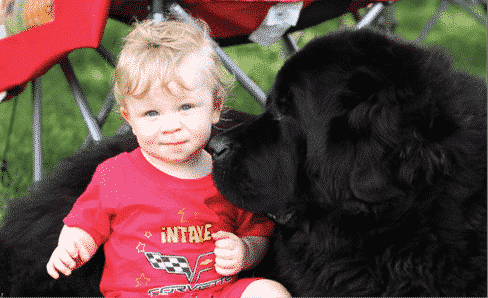
A sense of dignity, strength, and power are softened by a benevolent demeanor. Any indication of ill temper is especially to be guarded against.
Size, Proportion & Substance
The Newfoundland is a large, heavily coated, well-balanced dog that is deep-bodied, heavily boned, muscular, and strong. A good specimen of the breed has dignity and a proud head carriage.
Average height for adult dogs is 28 inches; for adult bitches, 26 inches. Approximate weight of adult dogs ranges from 130 to 150 pounds; adult bitches from 100 to 120 pounds. These are not minimums or maximums. Large size is desirable, but never at the expense of balance, structure, and correct gait. The Newfoundland is slightly longer than tall when measured from point of shoulder to point of buttocks, and from withers to ground; a dog of considerable substance, which is determined by spring of rib, strong muscle, and heavy bone.

It is helpful in judging to have an idea of the proportions of an animal. In the Newfoundland, the following proportions are approximate: 1) They are slightly longer than tall. 2) The skeletal structure, measured from the withers to the lowest part of the chest (brisket), should be at least 50% of the dog’s total height. However, skin, muscle, and coat make this distance appear proportionally greater so that, in profile, it appears to be approximately 55%. 3) The distance from withers to elbow is approximately 50% of the total height, and from elbow to ground, about 50%. Variations in these proportions become apparent when the dog moves and appears to be “running downhill.”
Expression is soft and reflects the characteristics of the breed; benevolence, intelligence, and dignity.
Head
The head is massive, with a broad skull, slightly arched crown, and a strongly developed occipital bone. Cheeks are well-developed. Eyes are dark brown; they are relatively small, deep-set, and spaced wide apart. Eyelids fit closely, with no inversion. Ears are relatively small and triangular with rounded tips. They are set on the skull level with, or slightly above, the brow, and lie close to the head. When the ear is brought forward, it reaches to the inner corner of the eye on the same side. Expression is soft and reflects the characteristics of the breed; benevolence, intelligence, and dignity.
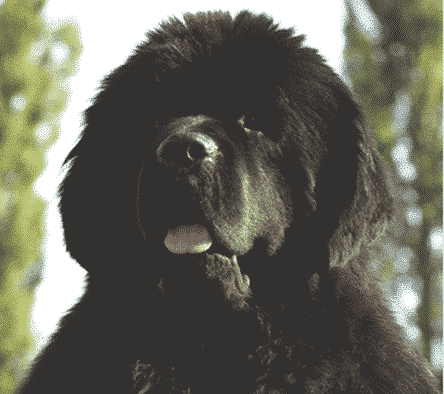
Eyes that are prominent, bulgy, set too close together, and/or light-colored serve to spoil the soft, sweet Newfoundland expression. The shape of the eyes is a major factor in the desirable sweet expression. Light eyes in browns and grays are not penalized, per se, but a poor expression, whether due to eye color, shape, or placement, should be penalized in dogs of any coat color. The eyelids must fit closely, to give good protection to the eyes from water and brush.
The muzzle should be in balance with the head of the individual animal, never excessively long, pointed, or snipey. The top of the muzzle is rounded. Level and scissors bites are equally acceptable. Dropped lower incisors are found in many specimens of the breed and should be considered only a minor deviation.
NECK, TOPLINE, BODY
The neck is strong and well set on the shoulders, and is long enough for a proud head carriage. The back is strong, broad, and muscular, and is level from just behind the withers to the croup. The chest is full and deep, with the brisket reaching at least down to the elbows. Ribs are well sprung, with the anterior third of the rib cage tapered to allow elbow clearance. The flank is deep. The croup is broad and slopes slightly.
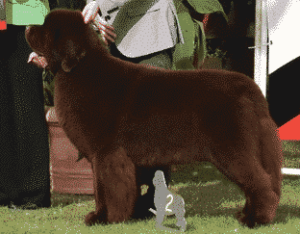
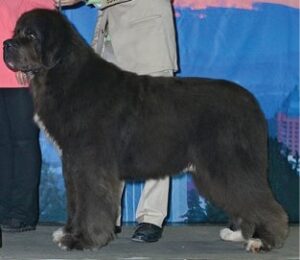
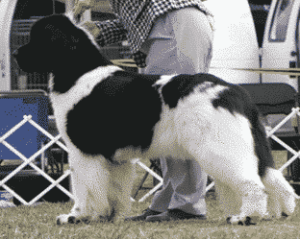
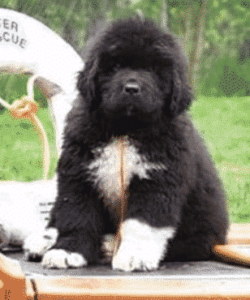
Tail set follows the natural line of the croup. The tail is broad at the base and strong. It has no kinks, and the distal bone reaches to the hock. When the dog is standing relaxed, its tail hangs straight or with a slight curve at the end. When the dog is in motion or excited, the tail is carried out, but does not curl over the back.
A Newfoundland should not be sway-backed, hollow-backed or soft in the back. They should be neither roached nor camel-backed. The natural coat, or grooming, may make a soft or hollow back appear level, or it can make a level back appear roached or high in rear. So, the back must be felt to determine its true conformation and musculature. The croup may also be distorted by coat and should be felt to determine its true slope. A flat croup makes for a high tail set. A too sloping croup throws the hindquarters under the dog and tends to destroy the power that should be developed there. Both conditions spoil the general outline of the dog. The croup should never be higher than the withers.
Shoulders are muscular and well laid back. Elbows lie directly below the highest point of the withers. Forelegs are muscular, heavily boned, straight, and parallel to each other, and the elbows point directly to the rear. Pasterns are strong and slightly sloping. Feet are proportionate to the body in size, webbed, and cat foot in shape. Dewclaws may be removed.
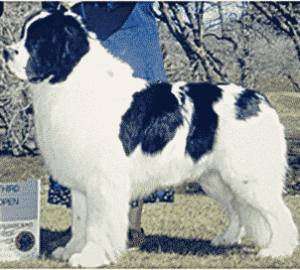
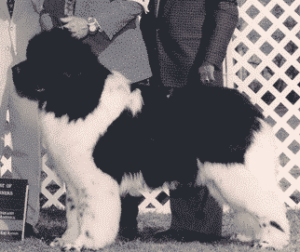
Bone should be in proportion to the size of the dog. A heavy coat can add false visual dimension to bone, so it should be felt for size and comparison. A standard location to assess bone is the forearm, just above the pastern. A Newfoundland should never be faulted for having too much bone.
The rear assembly is powerful, muscular, and heavily boned. Viewed from the rear, the legs are straight and parallel. Viewed from the side, the thighs are broad and fairly long. Stifles and hocks are well bent, but not so as to give a crouching appearance. The line from hock to ground is perpendicular. Hocks are well let down. Well-bent stifles and hocks provide flexibility. One should be able to see the entire pads of the rear feet of a dog as they move away.
Coat
The adult Newfoundland has a flat, water-resistant, double coat that tends to fall back into place when rubbed against the nap. The outer coat is coarse, moderately long, and full, either straight or with a wave. The undercoat is soft and dense, although it is often less dense during the summer months or in warmer climates. Hair on the face and muzzle is short and fine. The backs of the legs are feathered all the way down. The tail is covered with long, dense hair.
COLOR
Color is secondary to type, structure, and soundness. Recognized Newfoundland colors are black, brown, gray, and white and black. Solid colors may appear as solid colors or solid colors with white at any, some, or all of the following locations: Chin, chest, toes, and tip of tail. Any amount of white found at these locations is typical and is not penalized. Also typical are a tinge of bronze on a black or gray coat, and lighter furnishings on a brown or gray coat.
ANY amount of white on a black dog is permissible. ANY amount of white on a brown or grey dog is permissible, and is penalized only to the extent that white appears to be the base color.
Landseer: A white base coat with black markings. Where the predominant color is white, any amount of black is acceptable. Clear white or white with minimal ticking
is preferred.
Gait
The Newfoundland in motion has good reach, strong drive, and gives the impression of effortless power. The gait is smooth and rhythmic, covering the maximum amount of ground with the minimum number of steps. Forelegs and hind legs travel straight forward. As the dog’s speed increases, the legs tend toward single tracking. When moving, a slight roll of the skin is characteristic of the breed. Essential to good movement is the balance of correct front and rear assemblies.
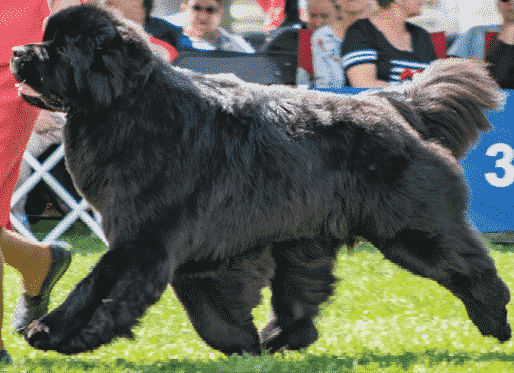
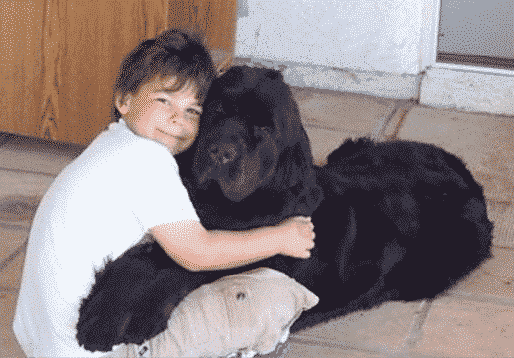
Strength and coordination are valued over speed. A Newfoundland is properly shown at a moderate trot. The correct level topline of the dog must not be lost in motion. It is important to distinguish good, ground-covering drive from an exaggerated rear action with considerable lift and flexing of the stifle, which lacks actual ground-covering
forward motion.
Newfoundlands have strong, well cushioned, compact feet, which hold up well over distances. Strong, slightly sloping pasterns will not break down under a day’s work. The webbing of the feet helps in propelling strokes while swimming. It has been suggested that the quite common toeing-in of the forelegs can be excused in Newfoundlands, “Since they are swimming dogs.” There is no good evidence that this deviation from the standard is in any way an aid in swimming or in hauling.
TEMPERAMENT
The Newfoundland is typically friendly. Since sweetness of temperament is the most important single characteristic of the breed, shyness, fearfulness, and suspicion are unacceptable traits and should be penalized severely. Chapter 14, Section 8-a of the AKC rules provides for excusal or disqualification for dogs that menace or attack humans. Furthermore, it is not acceptable for a Newfoundland to menace or attack other dogs, and any Newfoundland doing so should also be severely penalized.
DISQUALIFICATIONS
Any colors or combinations of colors not specifically described are disqualified: Any color other than white on a black, brown or grey dog; any color other than black on a Landseer. Note that there is no mention of markings. With respect to disqualifications, markings are considered only when they are the wrong color.
TRENDS
For many years, we have talked about proportions in the Newfoundland and a hands-on evaluation of those proportions. The Newfoundland of thirty years ago did not have enough leg to balance out the appropriate proportions. Short front legs were very apparent at that time, but are not seen as often today. However, we are seeing many tall, narrow dogs that are slab-sided and lacking the substance that is desired in a Newfoundland. As a true working dog, the standard is specific. The Newfoundland is a dog of considerable substance, which is determined by spring of ribs, strong muscle, and heavy bone. Our standard is specific: “Large size is desirable, but never at the expense of balance, structure and correct gait.” It is all about the balance.
Article, Photos, and Illustrations Provided by the Newfoundland Club of America
